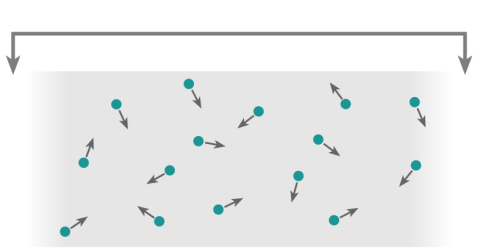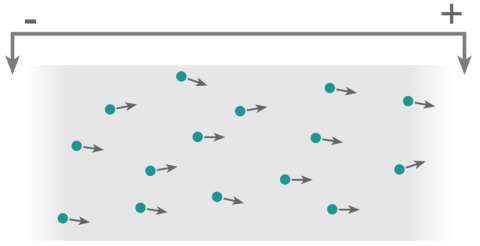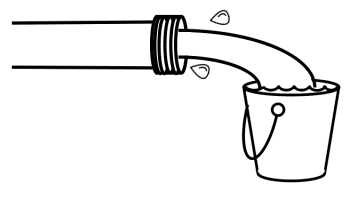An electric current is a flow of electric charge in a circuit - the flow of free electrons between two points in a conductor. These free electrons in motion is what constitutes electrical energy. Electricity production consists of forcing electrons to move together in a conducting material by creating an electron deficit on one side of the conductor, and a surplus on the other.
The device that produces this imbalance is called a generator. The terminal on the surplus side is marked +, that on the deficit side –.
When a load is connected to the generator’s terminals, the generator pushes electrons: it absorbs the positive charged particles and sends back the negatively charged particles. In a circuit, the electrons circulate from the – terminal to the + terminal.
To be able to use electrical equipment properly and safely it is important to understand electricity works. It is vital to understand the three basic building blocks required to manipulate and utilise electricity - voltage, current, and resistance - and how the three relate to each other.
Electrical Charge
Electricity is the movement of electrons. Electrons create charge, which are harnessed to produce power. Any electrical appliance - a light-bulb, a phone, a refrigerator - are all harnessing the movement of the electrons to work. The three basic principles for this guide can be explained using electrons, or more specifically, the charge they create:
- Voltage - The difference in charge between two points.
- Current (Ampere) - The rate at which any given charge is flowing.
- Resistance - A material’s tendency to resist the flow of charge (current).
These values describe the movement of charge, and thus, the behaviour of electrons.
A circuit is a closed loop that allows charge to move from one place to another. Components in the circuit allows to control this charge and use it to do work.
Electric Measurements
- Power - The energy consumed by the load.
- Energy - The amount of electricity consumed or produced during a given period of time.
Electric Potential Difference (Voltage)
Voltage (U) is defined as the amount of potential energy between two points on a circuit. This difference in charge between the + and – poles in a generator is measured in volts and is represented with the letter “V". Sometimes voltage can be called “electric pressure,” an appropriate analogy because the force provided by electric potential difference to electrons passing through a conductive material can be compared to water pressure as water moves through a pipe; the higher the volts, the greater the “water pressure”.
The available energy of the free electrons in motion is what constitutes electrical energy. Electricity production consists of forcing the electrons to move together through a conducting material by creating an electron deficit on one side of the conductor, and a surplus on the other. The terminal on the surplus side is marked (+), that on the deficit side (–).
Voltage is determined by the distribution network. For example, 220 V between the terminals of most electrical outlets, or 1.5V between the terminals of a battery.
Electrical Current
An Electrical Current (I) is the flow of free electrons between two points in a conductor. As electrons move, an amount of charge moves with them; this is called current. The number of electrons that are able to move through a given substance is governed by the physical properties of the substance itself conducting the electricity - some materials allow current to move better than others. Electrical current (I) is expressed and measured in Amperes (A) as a base unit of electrical current. Typically, when working with electrical equipment or installations, current is usually referred to in amperes. If volts (V) can be compared to the water pressure of water passing through a pipe, amperes (A) can be compared to the overall volume of water capable of flowing through the pipe at any given moment.
The motion of the free electrons is normally random, resulting no overall movement of charge. If a force acts on the electrons to move them in a particular direction, then they will all drift in the same direction.
Diagram: Free electrons in a conductive material with and without current applied.
When a light bulb is connected to a generator, a certain quantity of electrons passe
s through the wires (filament) of the bulb. This electron flow corresponds to the current (I), and measured in amperes (A).
Current is a function of: The power (P), The voltage (V), and the resistance (R).
Resistance
Sometimes electrons are held within their respective molecular structures while other times they are able to move around relatively freely. The resistance of an object is the tendency of this object to oppose to the flow of electric current. In terms of electricity, the resistance of a conductive material is a measure how the device or material reduces the electric current flowing through it. Every material has some degree of resistance; it can be very low – such as copper (1-2 ohm per 1 meter) – or very high – such as wood (10000000 ohm per 1 meter). As an analogy to water flowing through a pipe, resistance is bigger when the pipe is narrower, decreasing the flow of water.
In two circuits with equal voltages and different resistances, the circuit with the higher resistance will allow less charge to flow, meaning the circuit with higher resistance has less current flowing through it.
The Resistance (R) is expressed in ohms. Ohm defines the unit of resistance of “1 ohm” as the resistance between two points in a conductor where the application of 1 volt will push 1 ampere. This value is usually represented in schematics with the Greek letter “Ω”, which is called omega, and pronounced “ohm”.
For a given voltage, the current is proportional to the resistance. This proportionality, expressed as a mathematical relationship, is known as Ohm’s Law:
For a constant voltage, increasing the resistance will reduce the current. Conversely, the current will increase if the resistance is lowered. At constant resistance, if the voltage increases, so will the current. Ohm’s Law is valid only for pure resistance, i.e., for devices that convert electrical energy into purely thermal energy. With motors, for example, this isn’t the case.
Electrical devices may have purpose-built resistors which limit the current that flows through a component, so that component is not damaged.
Resistance determined by load. For example, wire conductors with a larger cross section offer less resistance to current flow, resulting in a smaller voltage loss. Inversely, resistance is directly proportional to the length of the wire. To minimise voltage loss, a current needs the shortest possible wire with a large cross-section. (see cabling section) Note also that the kind of wire (copper, iron, etc.) also affects a cable’s resistance.
When the resistance in an electrical circuit is near zero, the current may become extremely large, sometimes resulting in what is called a “short-circuit.” A short-circuit will cause an overcurrent within the electrical circuit, and can cause damage to the circuit or device.
Power
Electric power (P) is the amount of work done by an electric current in a unit of time. It represents the amount of energy consumed by a device connected to the circuit. It is calculated by multiplying the voltage by the current, and is expressed in Watts (W).
The more powerful the load, the more current it draws. This calculation is useful when analysing power needs.
| Power Vs. Energy | |||
|---|---|---|---|
POWER
|
| "like the flow rate of water"
| |
ENERGY
|
| "like the water that ends up in the bucket"
| |
Power is determined by the load.
| Example: | A 40W light bulb plugged into a 220V outlet draws a current of 40/220 = 0.18A. A 60W light bulb plugged into a 220V outlet draws a current of 60/220= 0.427A. |
|---|
Energy Consumption
Energy consumption is the amount of electricity produced or consumed during a given period of time. This is calculated by multiplying the power of a device by the duration of its use, expressed in hours, expressed in kilowatt-hours (kWh).
| Example: | A 60W light that’s left on for 3 hours will consume 180Wh, or 0.18kWh. |
|---|
This is the unit of consumption that adds up on the electric meter to determine any electricity bill.
Electric energy is often confused with electric power, but they are two different things:
- Power measures capacity to deliver electricity
- Energy measures total electricity delivered
Electric energy is measured in Watt-hours (Wh), but most people are more familiar with the measurement on their electric bills, kilowatt-hours (1 kWh = 1,000-watt-hours). Electric utilities work at a larger scale and will commonly use megawatt-hours (1 MWh = 1,000 kWh).
Effects
Depending on the nature of the elements through which it passes, electric current can have several physical effects:
| Effect | Description | Application Examples |
|---|---|---|
| Thermal Effect |
|
|
| Chemical Effect |
|
|
| Magnetic Effect |
|
|
| Photovoltaic Effect |
|
|
Adapted from MSF







